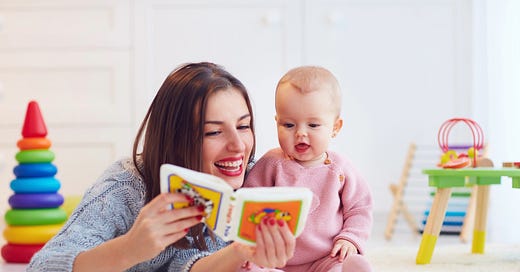The Marvel (and Mystery) of Speech
If you are like me when my kids were small you probably listen to your baby coo or babble and wonder if they’re on the right track in terms of their speech. As parents, we keep an eye on every new sound and syllable, hoping it’s a sign that our child is picking up language skills just fine. There’s a lot of advice - some of it contradictory - floating around online, and it’s easy to feel anxious. You might even lose sleep obsessing over whether your baby’s “ba-ba” is on schedule or if they should be saying full sentences by now (spoiler: they shouldn’t).
The important thing to remember is that your baby is not enrolled in Baby Olympics! Speech development is a journey unique to each baby and family circumstance, not a competition. Over the first two years, your baby lays the groundwork for interaction, communication, and (eventually) those adorable but challenging “Mommy, where do babies come from?” conversations. So in part 3 of 3 of my developmental series, let’s calm those nerves, have a little chuckle at the wild world of parenting advice, and dive into what really matters: understanding the milestones, helping your child along, and knowing when you might need a little extra help.
And honestly, my personal favourite is when babies accidentally curse. Nothing like a tiny human mispronouncing "truck" of “stick” in front of the grandparents to lighten the mood!
What Are Milestones, Anyway?
When we talk about developmental milestones, we’re referring to skills and behaviours that most children achieve by a certain age. Think of it like a roadmap. Each milestone represents a general point by which many children can do something—like babble, say a first word, or start combining words. Milestones are a guide, not an exact science. Each child follows their own pace, and there’s a range of what’s normal. But they do help us spot potential red flags if a skill is significantly delayed.
Speech and language development doesn’t just involve speaking; it’s a combination of several skills that grow together. Expressive language refers to what your child can produce to communicate—this includes sounds, words, and eventually phrases. It’s the “output” of language, like saying “mama” or imitating animal sounds. Receptive language, on the other hand, is about what your child understands. This is the “input” of communication, like recognizing their name, following simple instructions, or reacting to the word “no.” Finally, gestural communication is the use of body language to convey meaning before (or alongside) words. This includes pointing, waving, or shaking their head. Together, these three aspects work in harmony as your baby learns how to interact with the world—whether by smiling back at you, pointing to their favourite toy, or finally saying “cookie!”





